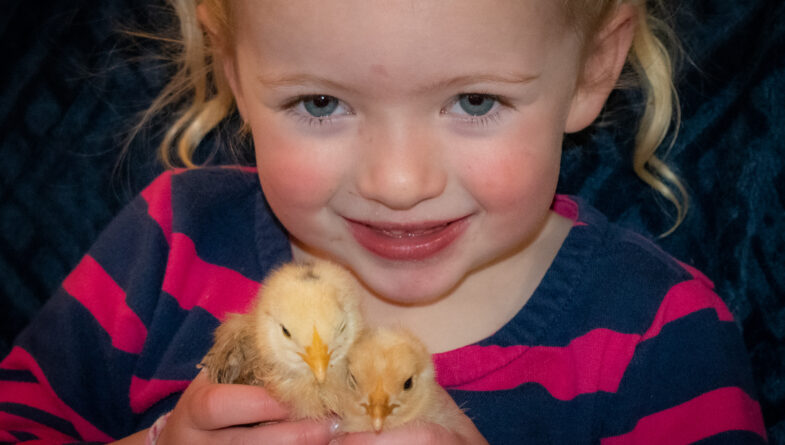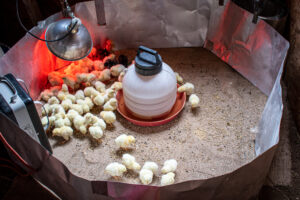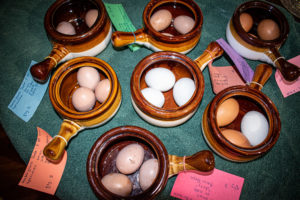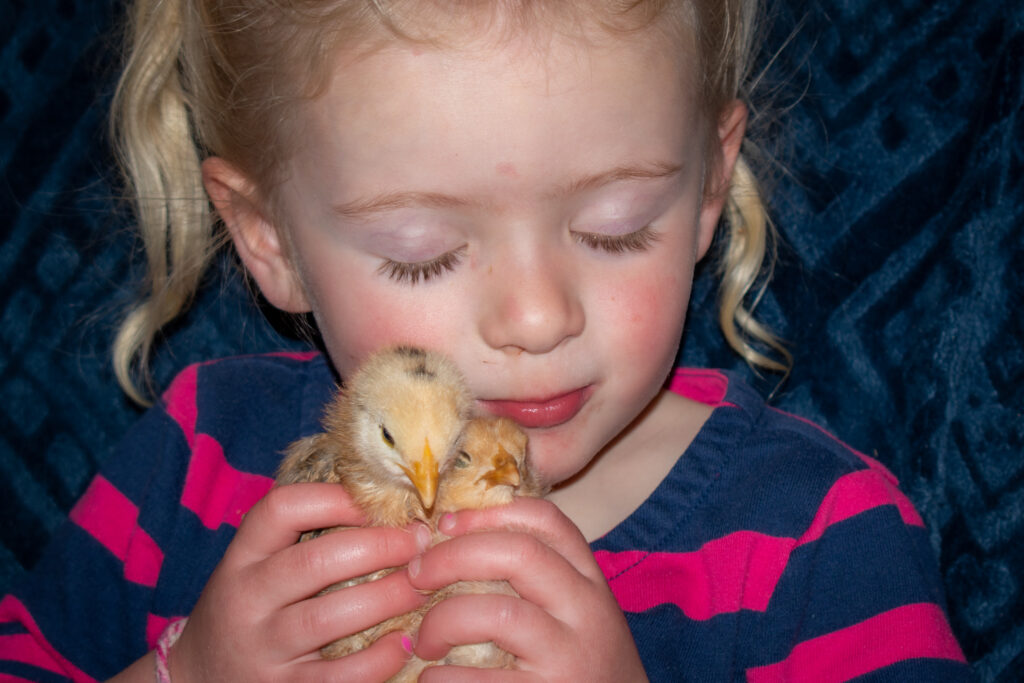Keeping Chickens – 10 Mistakes Newbies Make

These are some of the top ten mistakes those new to keeping chickens often overlook in their quest for fresh eggs from the backyard! Read on to boost your chances of chicken keeping success!
10. Not keeping the chicks warm enough

A chicken’s body temperature is normally between 105 and 107 degrees Fahrenheit. This enables the broody hen to keep her eggs (and newly hatched chicks) at about 100 degrees. You should provide a similar, draft-free environment for your baby chicks for the first several weeks of their lives. Then gradually reduce the temperatures but provide needed warmth until the chicks are fully feathered (usually about one month). You’ll know that the temperature is comfortable for them if they are moving around happily and not all bunched up together in the warmest spot.
9. Using cedar shavings in the chicken coop

Any aromatic wood shavings (pine or cedar) contain terpenes (organic compounds that help to deter herbivores from browsing the trees). These can be hard on an animal’s liver. Cedar specifically, also contains plicatic acid. Inhaled into the lungs from the smallest particles of cedar shavings, plicatic acid induces many breathing problems and leads to weak animals who succumb to opportunistic illnesses. Cedar wood shavings have negative effects on other livestock (and humans!) as well. Better options for very young chicks are burlap or some smooth surface with good traction. For older birds, some people prefer the deep litter method where clean straw is simply added on top of the mess and the whole lot is cleaned out once a year or every few months as needed. This method has some surprising benefits, especially in cold climates. Some chicken owners prefer a sand floor which tends to stay dry and can usually be kept clean by sifting the chicken messes by hand (not a fun chore but doable if not put off often).
8. Thinking of chicken waste as … waste.
No one LIKES cleaning the chicken coop and it seems like the little ladies fire their crap canons on the most annoying trajectories in the coop. But every dark stain has a green lining…. This plethora of poo is a boon to your bushes. A few ways to utilize the baleful bounty:

- compost the coop cleanings and apply the compost in your veggie gardens
- tractor your chickens over the yard to distribute the nitrogen bombs in your grass
- park the tractor over next year’s garden spot and let them kill the grass, eat the weed seeds and grubs, AND till in their fertilizer to jump start the growing season (adding kitchen scraps causes them to assist the composting process in situ as well)
- compost tea for your houseplants
- chicken waste is “hot” (high nitrogen) and can burn some plants if applied directly to them, but many nitrogen lovers (like tomatoes and corn) will enjoy a moderate amount of even fresh poo side dressed out side the immediate root zone
- You can also sell the excess although this breaks some permaculture foundational principles.
7. Keeping chickens in an sub-par coop

Chickens walk around like little dinosaurs and if you’ve ever watched a grown man run across the yard, screaming, with a rooster in hot pursuit, you’d think these birds are some tough jungle fowl. Indeed, if you are a bug, a mouse, or an earthworm, you should fear for your life. But when it comes to trying to keep our darling birds alive, we soon realize that those biddies are little more than walking chicken tenders coated loosely with soft feathers. Everything and their mothers eat chicken. Even animals that don’t want to hurt the chickens often kill them just playing with them. While there is some variation in common sense among breeds, all of them become comatose vegetables at nigh with zero fight or flight response. You need to have a rock solid coop that is impenetrable by dogs, raccoons, weasels and ideally even snakes or you WILL lose chickens even in the suburbs, given time (and it takes five to six months of mothering to even begin to get eggs).
6. Worrying too much about keeping the chickens warm and not enough about ventilation.
Keeping chicks warm enough is essential to their healthy and happy development. However, older and fully feathered chickens are more likely to suffer from being kept in an inadequately ventilated coup than from being too cold. Protect them from strong drafts and keep their litter dry and chickens can tolerate a surprising amount of cold weather considering the absence of “fat pad” on these laying hens.
Only those of you with winters consistently below zero probably need to worry about “too cold” for the chickens.
5. Not putting the girls to work – even before they are laying eggs
A key principal of permaculture design is keeping loops in your environment closed. Don’t think the answer to a problem is buying in a disposable solution unique to that problem. You want to build a web of interlocking parts and discover some of the magic that happens when unexpected symbiotic relationships develop around you. Think: keeping a cat instead of setting mouse traps with cheese; putting the cow in the harvested corn field to break down the stalks and return the organic matter to the soil biome, sweeping the spilled Cheerios into the chicken scrap bucket rather than chucking them in the trash for the landfill, etc. Chickens are super flexible “web developers” who fill many niches in you homestead. As I write, our chickens are patrolling the blueberry patch and the orchard to help us tame an out-of-control vole infestation. Some other ways chickens can help you out are:

- Second probably only to the pig, they are great “waste consumers” and composters
- They are an impressive weapon in your arsenal in the war with insect pests
- Their scratching feet put the fear of God in voles and moles who seldom infest a chicken yard
- Their poop is a nitrogen powerhouse and greens up the garden or the yard if properly composted or spread
- They can do light tilling in after-season gardens and eat any insects inclined to over winter into the bargain
4. Not anticipating dust bathing needs.
Chickens dust bathe to keep clean. The dust helps to regulate oil levels in their outer feathers, helping them to maintain “water resistance” as well as deterring mites and lice. Dust bathing is a strong instinct in chickens and they’ll usually find a way to do it even if you don’t facilitate the process. Providing them with an easy spot to obtain a good, dry “dust bowl” may save you from them digging holes in the yard where you don’t want them (well mulched flower beds are a favorite!).
3. Expecting an egg a day from every hen

Egg production is something that varies immensely between breeds. Some hybrid breeds like the Golden Comet can produce up to 280 eggs a year. Many popular breeds like Plymoth Rocks and Orpingtons lay something around 200 in a year. Nature’s way is that egg production is typically high in the spring and early fall months and lowest when chickens are molting (replacing their feathers) or during the winter. A flock that produces 6-7 eggs a day at its peak may only produce 1-2/day in the colder months. Also, chickens usually lay best for the first two years and then production gradually declines. If consistent production is an important goal, consider regular replacements of your flock and look into preserving the bounty of the high production months to tide you over in the slow times.
2. Not planning for the long haul
Most people who don’t buy chicks entirely on impulse (the peeping balls of fuzz ARE irresistible) understand that they are looking at 5-6 months of feeding, cleaning, and care before they even realize a single egg. We’ve touched on some of the other aspects of chicken care that should be considered such as flock replacement as aging chickens produce fewer eggs. Can you keep the “retired girls” in feed and healthy along with the producing replacements? Will you turn them into bone broth? Turning older laying hens into dinner is seldom worthwhile.
On the positive side, as the many pleasures of keeping chickens unfold for you, one ought to be aware that this thing called “chicken math” is a real thing. That carefully calculated flock of eight birds to meet your family needs almost universally becomes 20 or more birds before you’re aware of it. Do you have accountability to keep that in check or the space to handle them responsibly if you can’t?
1. Not cuddling the girls enough.

Many people start keeping chickens as a means of having fresh eggs reliably and controlling a small portion of their own food supply. What many people don’t anticipate is what diverse and wonderful personalities poultry have and are surprised when they fall in love with their girls (and sometimes the boys). This plays a big part in that “chicken math” thing. Happy chickens (and some varieties more than others) enjoy a good cuddle. Our first flock were all Buff Orpington and they would all 12 try to climb into our lap the moment you sat down in the yard.
I trust that browsing this list has not only given you some ideas about how to enjoy your new or prospective flock but that it will give you the confidence to start on this journey toward sustainability and loving it!
